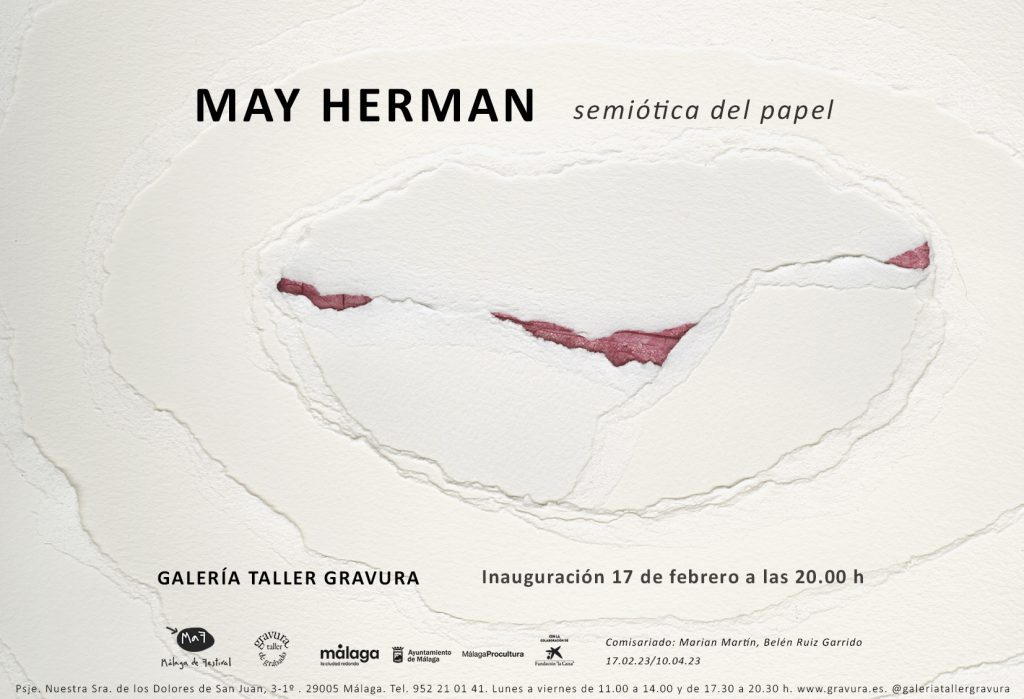May Herman. Paper semiotics.
Words/riddles. What? May Herman's papers question themselves. The interrogation is revealed from its fabricated fragility to question with enigmatic forcefulness. We trace other self-absorbed traces of writing on small fragments of paper, lines written by hand with the delicacy of someone who does not want to hurt the support or reveal thoughts. Only visible to the scrutinizing gaze. Subtle missives that demand the stopped step. Just to invoke the diverse nature of creation. Solely to suggest that its ways will make us wander. And whispers. Much remains to be written...
Papers/encounters. However, its compositions do not need words to express themselves. The working method reveals that it is the creative process that sets the standards. The author works without previous approaches, assembling forms in the future of the work itself. The encounters with the material are eloquent and decisive in the process. Herman allows herself to be seduced, saves and pampers each sheet, each scrap, any fragment. Cuts out, reuses, tears, pastes, faces, superimposes, braids and weaves –she also uses fabrics and lace- the different qualities, origins -reuses engravings and plastics-, textures, tones, densities, transparencies and resistances. As the conductor or the choreographer knows and respects the singular natures, she makes them shine and lets their potentialities emerge, to later encourage them to dialogue. Then the magic of the poetics of her paper worlds occurs.
Shapes/signs. It is not difficult to imagine the artist absorbed in a patient, extremely neat, subtle and precious work, and, at the same time, determined, courageous, almost painful. Building a universe full of lyricism means being alert. And with this ideas arise and find a home, are embodied, are "recognized". The shapes become signs of a particular spelling with a collective scope. The abstract compositions order an apparent chaos, held in grids or braided; the wavy or rounded profiles excavate cavities of unfathomable depth or simulate organisms and intimate body landscapes; on other occasions, the interventions leave traces of marks and incisions that appear to be wounds. In this sense, her diverse disciplinary training, in psychology and fine arts, as well as the performance of pioneering work as a psychologist at the Women's Advisory Center, is significant. In the end, the entire life journey finds its place and the line of time blurs, becoming present. These explicit or referential cartographies of the body and psyche of women delve into inescapable cultural and biological aspects and address basic issues of feminist agendas. Under the appearance of a refined and clean aesthetic, abjection and darkness can be hidden. A double-edged sword that women know and suffer from. Those layers of significant forms consciously allude to gender disparity, the associated role crossings, and the characters linked to the construction of femininity, and also combine references to violence and oppression, depression, harassment, or rape.
Commitment/pleasure. We talk about the arts, while we enjoy the secrets, the laughter and the shared interests. It is not contradictory. The pleasure felt is contagious because May Herman's commitment is also with artistic creation and it goes through enjoyment. The artist is part of a genealogy that has overflowed the hierarchies of supports, genres and categories of artistic work traditionally carried out by women. Feminist historiography has reinforced this fundamental subversion. That is why Herman, woman, artist/craftswoman, mediator and experimenter, conceives her work in the need for revelation without renouncing enjoyment. It is suggestive to think of the artist cultivating her senses when she works, moving softly across smooth or rough surfaces, following straight lines to tackle reliefs and succumbing to gaps. The industriousness of her hands must have extracted sounds from the handled papers, despite the exquisite care. The neatness and elegance of the shades of white flood the pupil, and are interrupted by reddish spots like blood flowers, or a fine but incisive black line. Without pleasure there is no creation. Perhaps the pain can be conjured.
Belén Ruiz Garrido
Malaga University. University Institute
for Gender and Equality Research (IGIUMA)

